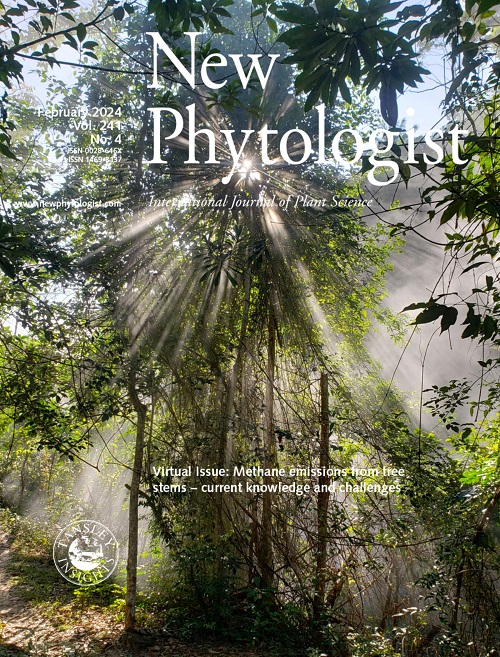北美东部落叶林叶片光合能力和水分利用效率的季节变化趋势及其对冠层尺度气体交换的影响
IF 8.1
1区 生物学
Q1 Agricultural and Biological Sciences
引用次数: 0
摘要
植物蒸腾(E)和光合碳同化(A)是季节性动态的,它们比值的变化决定了边际水分利用效率(WUE)。尽管了解气孔在调节水分利用效率中发挥机制作用,但气孔和非气孔过程如何影响生长季节水分利用效率的变化仍不清楚。因此,对冠层水分利用效率季节动态的主要生理驱动因素的了解有限,仍然是温带落叶森林生态系统碳水交换地球系统模型预测中最大的不确定性之一。我们研究了叶片水平生理、水力和解剖特性的季节模式,包括气孔斜率参数的季节变化(g1;与WUE成反比)和最大羧化速率(Vcmax)。Vcmax和g1随季节变化;然而,它们的模式不是暂时同步的。g1总体上呈上升趋势,直至季节后期,而Vcmax在盛夏月份达到峰值。Vcmax的季节变化主要受叶片结构和解剖特征的变化驱动,而g1期的季节变化与Vcmax和叶片水力的变化关系最为密切。使用季节变量Vcmax和g1参数化冠层尺度气体交换模型,季节累计a和E分别增加了3%和16%。本文章由计算机程序翻译,如有差异,请以英文原文为准。
Seasonal trends in leaf-level photosynthetic capacity and water use efficiency in a North American Eastern deciduous forest and their impact on canopy-scale gas exchange
- Vegetative transpiration (E) and photosynthetic carbon assimilation (A) are known to be seasonally dynamic, with changes in their ratio determining the marginal water use efficiency (WUE). Despite an understanding that stomata play a mechanistic role in regulating WUE, it is still unclear how stomatal and nonstomatal processes influence change in WUE over the course of the growing season. As a result, limited understanding of the primary physiological drivers of seasonal dynamics of canopy WUE remains one of the largest uncertainties in earth system model projections of carbon and water exchange in temperate deciduous forest ecosystems.
- We investigated seasonal patterns in leaf-level physiological, hydraulic, and anatomical properties, including the seasonal progress of the stomatal slope parameter (g1; inversely proportional to WUE) and the maximum carboxylation rate (Vcmax).
- Vcmax and g1 were seasonally variable; however, their patterns were not temporally synchronized. g1 generally showed an increasing trend until late in the season, while Vcmax peaked during the midsummer months. Seasonal progression of Vcmax was primarily driven by changes in leaf structural, and anatomical characteristics, while seasonal changes in g1 were most strongly related to changes in Vcmax and leaf hydraulics.
- Using a seasonally variable Vcmax and g1 to parameterize a canopy-scale gas exchange model increased seasonally aggregated A and E by 3% and 16%, respectively.
求助全文
通过发布文献求助,成功后即可免费获取论文全文。
去求助
来源期刊

New Phytologist
PLANT SCIENCES-
CiteScore
17.60
自引率
5.30%
发文量
728
审稿时长
1 months
期刊介绍:
New Phytologist is a leading publication that showcases exceptional and groundbreaking research in plant science and its practical applications. With a focus on five distinct sections - Physiology & Development, Environment, Interaction, Evolution, and Transformative Plant Biotechnology - the journal covers a wide array of topics ranging from cellular processes to the impact of global environmental changes. We encourage the use of interdisciplinary approaches, and our content is structured to reflect this. Our journal acknowledges the diverse techniques employed in plant science, including molecular and cell biology, functional genomics, modeling, and system-based approaches, across various subfields.
 求助内容:
求助内容: 应助结果提醒方式:
应助结果提醒方式:


